The defeat at Coronel left the British reeling. Even leaving aside the psychological effects of the Royal Navy's first defeat in a century, there was still the very practical problem posed by the existence of a powerful German force on the west coast of South America. Most likely, Spee would continue south, emerging into the South Atlantic to threaten the busy shipping lanes off the River Plate. But other options couldn't be ruled out. He might double back into the Pacific, with the intention of reaching the Indian Ocean or attacking commerce along the west coast of North America. And two and a half months earlier a new option had opened in the form of the Panama Canal.
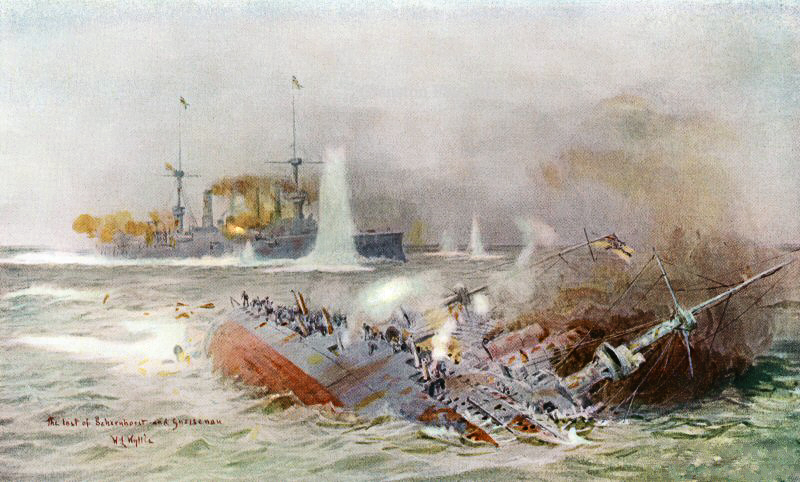
The man faced with responding to all of this was Jackie Fisher, who had resumed the position of First Sea Lord the day before Coronel, and he responded with his usual decision. Despite the fact that the balance of power in the North Sea was perilously close after the loss of Audacious, he quickly ordered three of the Grand Fleet's battlecruisers be dispatched to deal with the threat, along with a number of cruisers and pre-dreadnoughts. Invincible and Inflexible were to go south to the Falklands to cover the main route, under the command of Vice-Admiral Doveton Sturdee, previously Chief of the Naval War Staff, who Fisher hated and wanted gone. Both ships needed yard work, but in a premonition of things to come, Fisher gave them only three days and made it clear that they would sail with workers onboard if necessary. As they would 68 years later, the dockyards pulled it off, and the two ships set sail on the 11th. The next day, Princess Royal put to sea to bolster the North American station, under conditions of such secrecy that not even the commander of that station, Admiral Hornby, knew she was coming.
But the battlecruisers were only the tip of the iceberg in terms of the response. The existing squadron in the South Atlantic, armored cruisers Carnarvon, Cornwall and Defence, rendezvoused off Montevideo with Canopus and the survivors of Coronel, as well as cruiser HMS Kent, dispatched from the Cape Verde Station, and settled in to wait for Sturdee's arrival. In case Spee decided to head across the Atlantic for South Africa, battleship Glory and armored cruiser Minotaur were sent to the cape, soon reinforced by Defence from South America. Warrior and Black Prince, among the most modern armored cruisers in the RN, were ordered south from the Med to join the older Donegal and Highflyer to cover the possibility that Spee would try to attack the British and French colonies in central West Africa. In the Pacific, the British and Japanese combined their efforts, sending cruiser HMS Newcastle, battlecruiser HMAS Australia, battleship Hizen (the former Russian Retvizan) and armored cruiser Idzumo off the coast of southern California. Japan also handled the risk of Spee doubling back for the Indian Ocean, making plans to send four armored cruisers into the area around Fiji, and two more to the Caroline Islands, although Spee was defeated before they actually made the deployment.
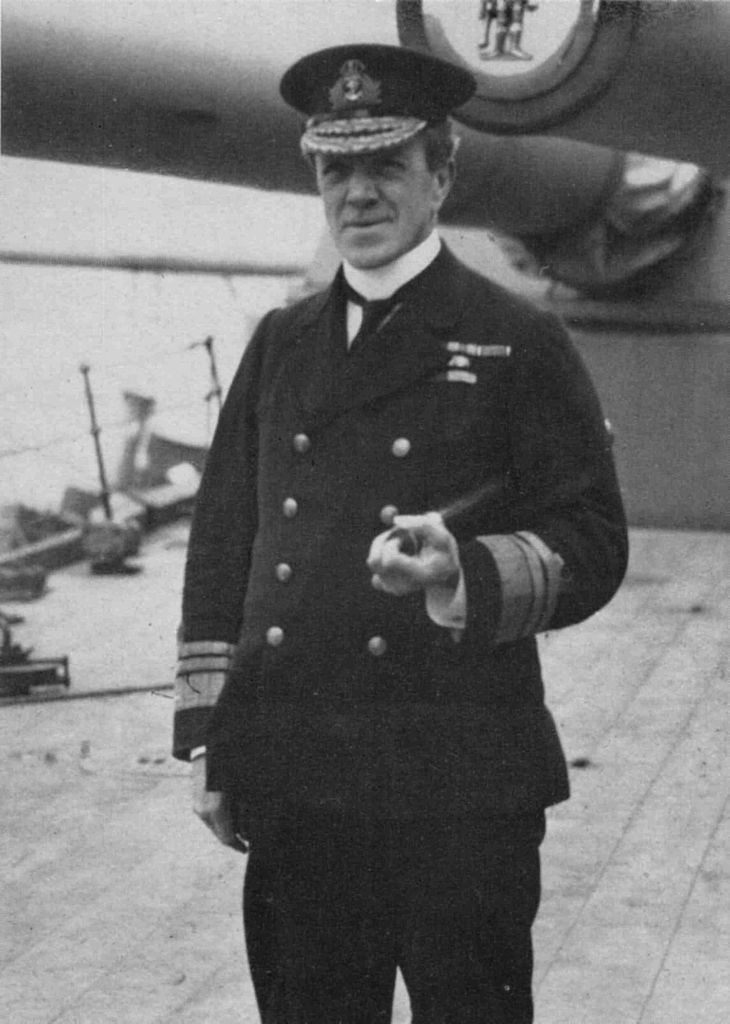
Doveton Sturdee
Spee appeared curiously unaware of the net closing in around him, and it was two weeks before he headed south for the South Atlantic. On the way, he stopped to coal for a second time, then paused in the Beagle Channel on the southern tip of Tierra del Fuego to take on coal from a captured British bark. There, he announced his plan to attack the Falkland Islands. His last intelligence had indicated would have no British ships present, and he was out of range of any wireless stations that could have told him about Sturdee's approach. Several of his captains objected, suggesting that the force appear off the Plate without warning, but he chose to push on, hoping to destroy the wireless station and coal stocks at Stanley.
Spee's pace was almost matched by Sturdee, who stopped several times to coal on the way south, and even for battle practice, which resulted in a 12-hour delay after a towing cable got tangled around one of Invincible's propellers. The battlecruisers finally anchored at Stanley on the morning of December 7th, and began coaling for their expected sweep into the Pacific, a process expected to take two days. All available units would go, with the exception of Canopus, which had been grounded as a defensive battery near Stanley.
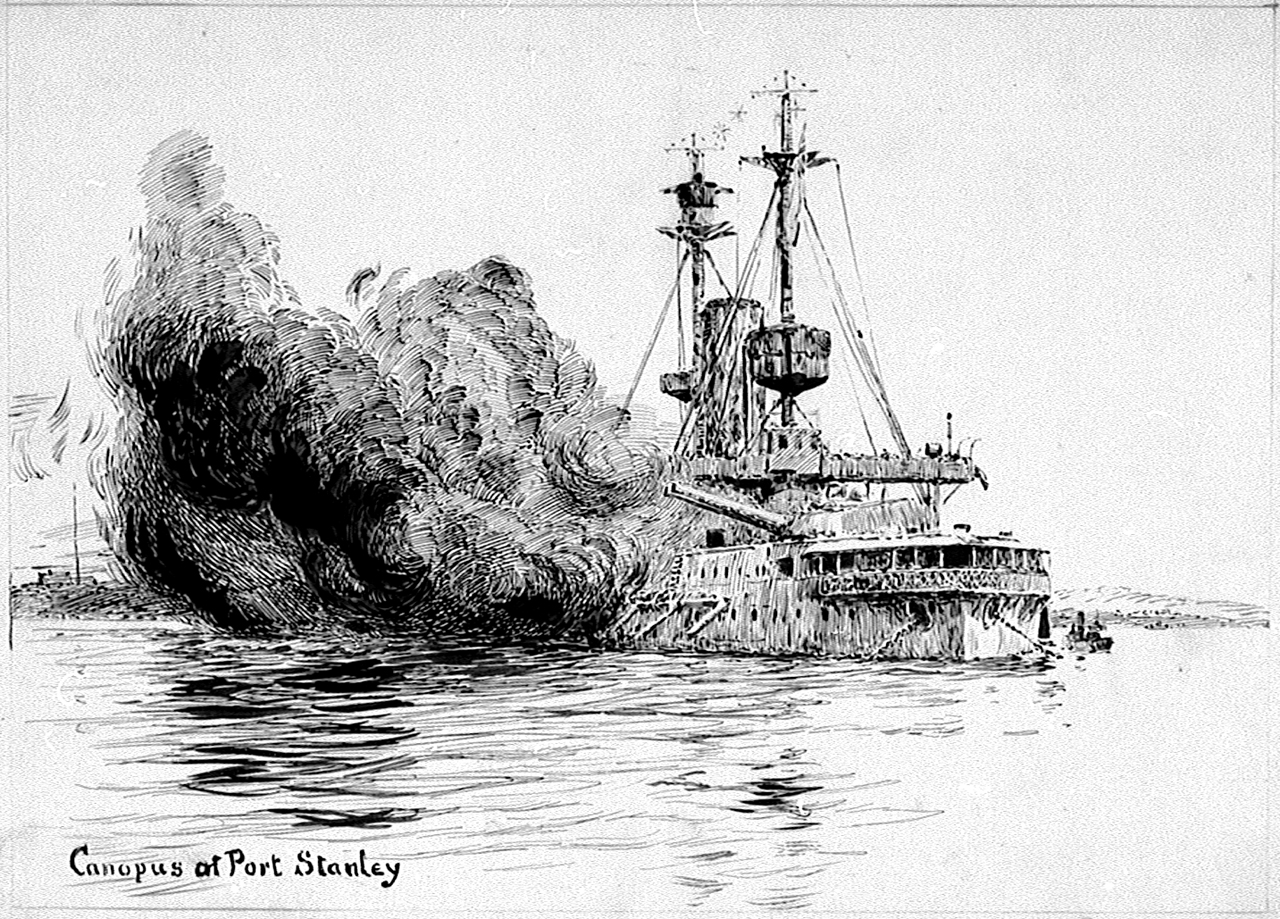
Canopus fires the first shots of the battle of the Falklands
At 8 AM on December 8th, Spee arrived off Port Stanley. All of Sturdee's ships, except for armored cruiser Kent, would take at least two hours to raise steam, in theory giving Spee a chance to catch the much stronger squadron in harbor. But he was expecting no trouble, and his force wasn't concentrated, giving the British a few extra minutes. More time was bought by a pair of salvoes from Canopus at around 0920, one of which fell close to Gneisenau and prompted Spee to turn back for a few minutes. She turned back to engage Kent, but was then ordered to withdraw as Spee realized that there were more ships present than he'd counted on, and that his best option was to make a run for it, the wisdom of which was underscored when the distinctive tripod masts of the British battlecruisers appeared shortly thereafter.
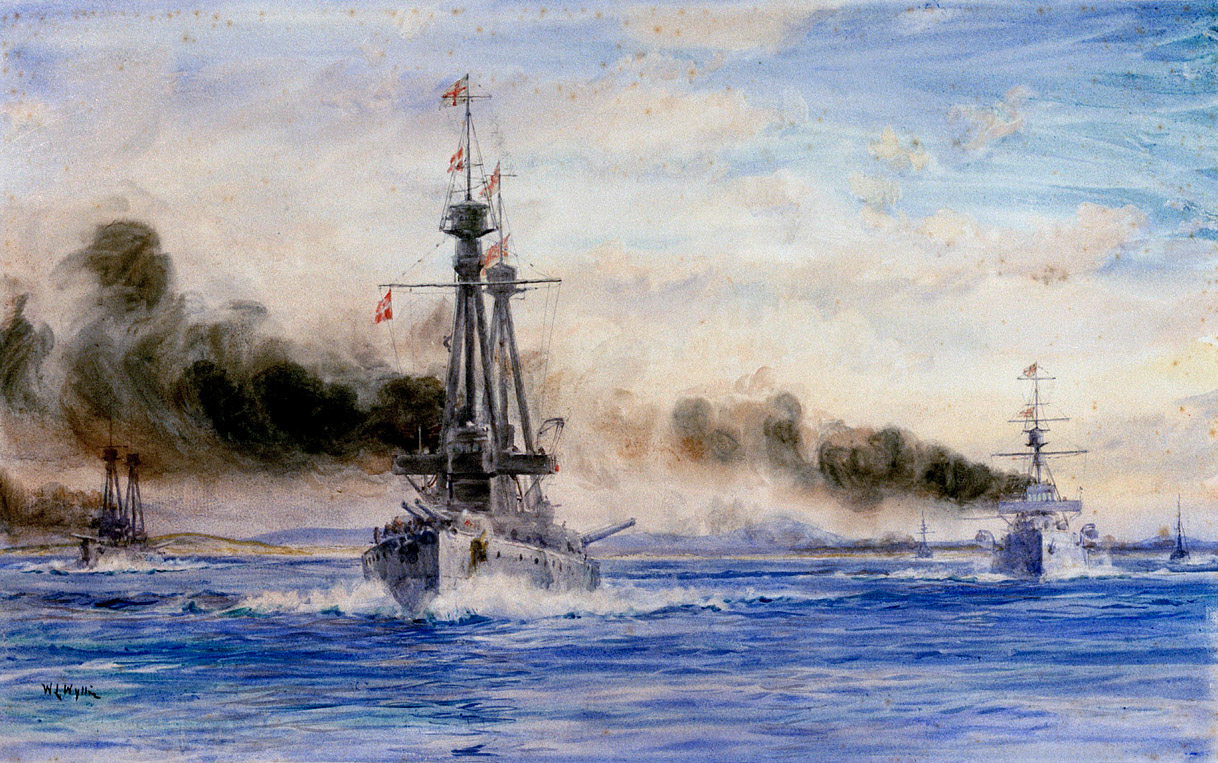
By 1030, Sturdee had Invincible, Inflexible, armored cruisers Kent, Carnarvon and Cornwall and light cruiser Glasgow in pursuit of the Germans. Even light cruiser Bristol, whose engines had been opened up for repairs, was about to get under way, although she had been detached to hunt down Spee's colliers, which had been ordered to stay south of the islands, and whose presence had been reported by one of the locals. Sturdee hoisted the signal "General Chase", giving his ships free rein to try and close the 15-mile gap to the Germans. Spee's only hope was that the weather in the South Atlantic, usually miserable, would hide him, but it was calm and clear, and Sturdee had 8 hours of daylight with which to hunt him down.
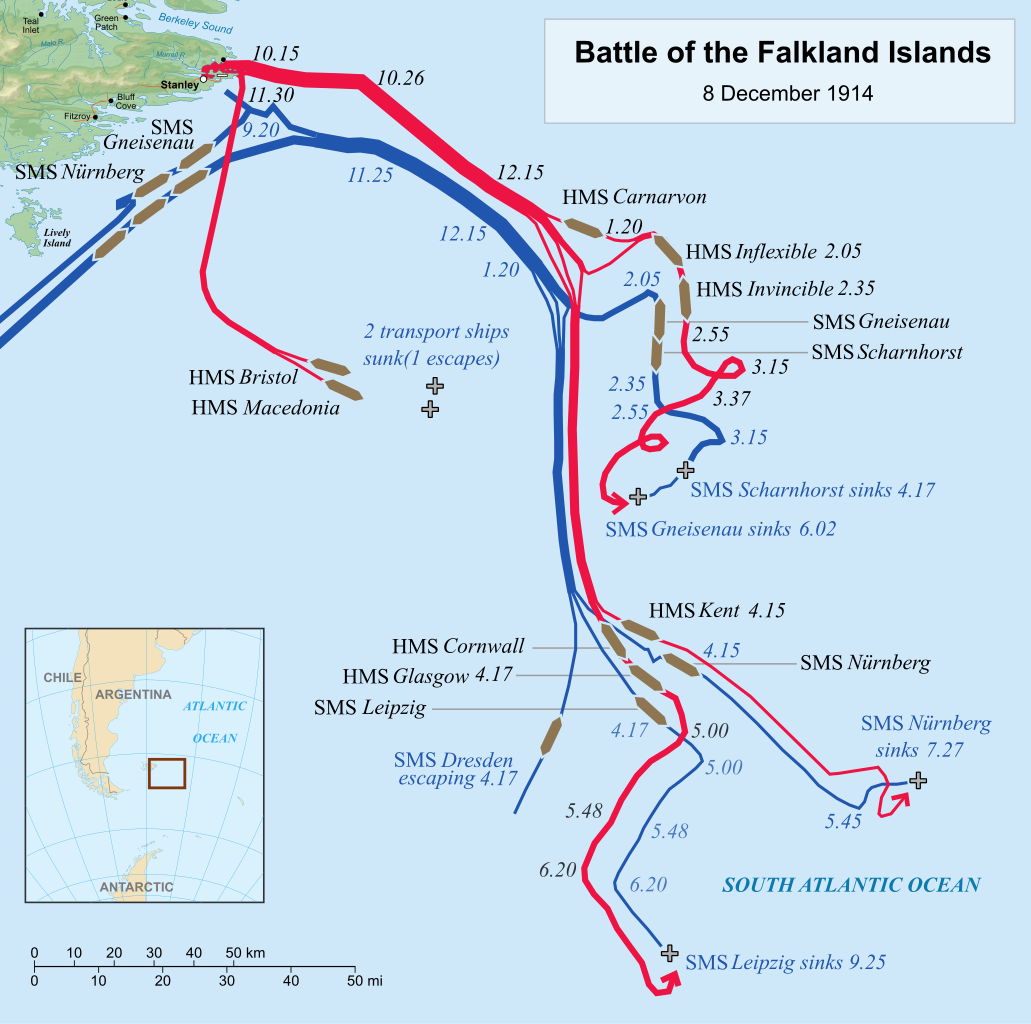
Initially, the battlecruisers raced ahead, belching huge clouds of black smoke, but Sturdee ordered their speed reduced to allow the armored cruisers to catch up, and to give the crews a chance for their midday meal. Finally, at 1247, they had closed to within 16,000 yards of Leipzig, Spee's last ship in line, and the battlecruisers opened fire. The long range meant that their early fire was ineffective, and after half an hour, Spee realized that there was no way for his entire force to escape. He ordered Scharnhorst and Gneisenau to turn and fight, hoping to cover the flight of the light cruisers, which could continue the campaign against British commerce. Sturdee had anticipated the move, and given orders to cover the contingency. Invincible and Inflexible continued on, while the other cruisers turned to pursue the German cruisers fleeing for the coast of South America.
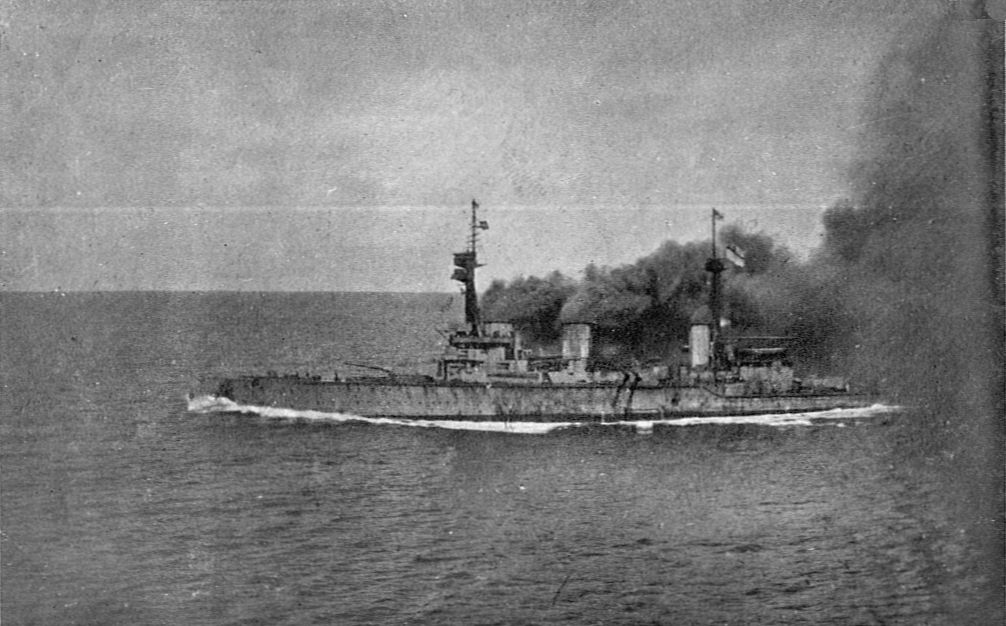
Invincible at speed during the battle
But the main action was between the big ships, both of which turned to the east around 1330, falling into parallel courses. Spee opened fire at about this point, and his gunnery was as good as ever, landing a hit on Invincible’s belt 15 minutes later. Sturdee opened the range slightly and began to hit back, landing three hits on Gneisenau and an unknown number on Scharnhorst in the next 15 minutes, before the guns fell silent and both forces turned south again. It took until 1448 for the British to bring Spee within range again, although this time Spee decided to try to bring them within range of his 5.9" secondary guns, closing to 10,000 yards by 1500. Both sides were hitting regularly, but the heavier shells of the battlecruisers were beginning to tell. Scharnhorst’s fire had turned ragged, and within half an hour they were down to 18 knots and Gneisenau was listing so much her secondary guns had fallen silent. By 1600, Scharnhorst was clearly doomed, and after signalling to her sister ship to keep running, she turned to try and delay the British. But even as late-arriving Carnaravon entered the action, the German cruiser slipped beneath the waves, taking every man aboard with her. It took another two hours to bring Gneisenau to heel, as fading light and drizzle conspired to shield her from British gunnery. Her crew fought to the very end, finally setting the scuttling charges when the end was inevitable and giving three cheers for the Kaiser as they abandoned ship. The British cruisers, now freed of other concerns, were able to pluck 177 survivors from the sea.
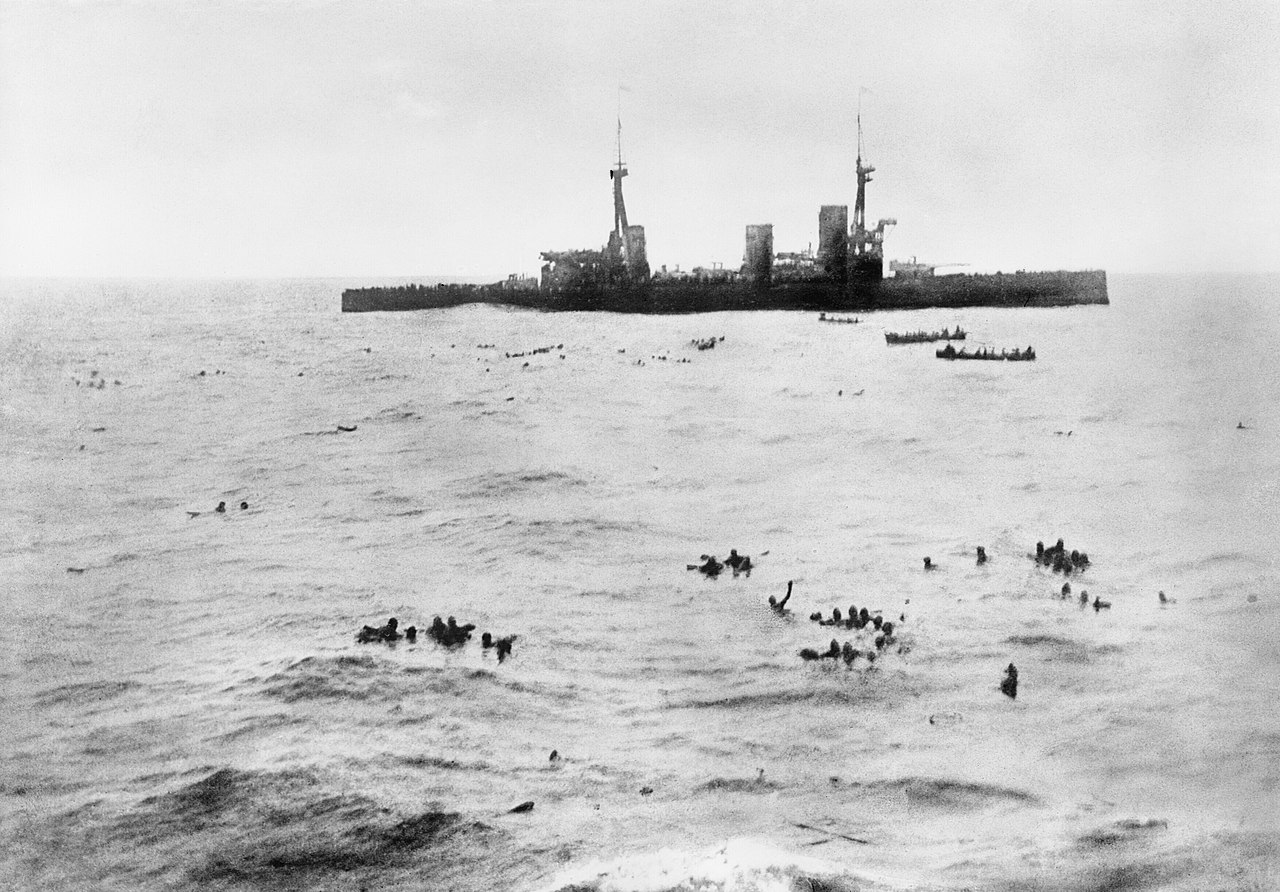
Inflexible rescuing survivors from Gneisenau
The German light cruisers had stuck together until shortly after Scharnhorst went down. Glasgow, Kent and Cornwall had all gotten into range, and the Germans again scattered. Dresden, in the best shape of the three, quickly disappeared from view. Kent pursued Nurnburg, while the other two headed after Leipzig. Kent, despite being so short on coal that her crew were burning furniture and her wooden deck, manage to overhaul Nurnburg after the German cruiser burst a boiler tube. Only seven men survived. Leipzig lasted slightly longer against her adversaries, but she too eventually was caught and sent to the bottom of the South Atlantic, with 18 of her crew rescued from the frigid water. Dresden would be caught several months later, after slipping back into the Pacific. On March 14th, the omnipresent Glasgow caught her off Juan Fernandez Island, and trapped her in harbor, where her crew chose, in the finest tradition of the German Navy, to scuttle her.
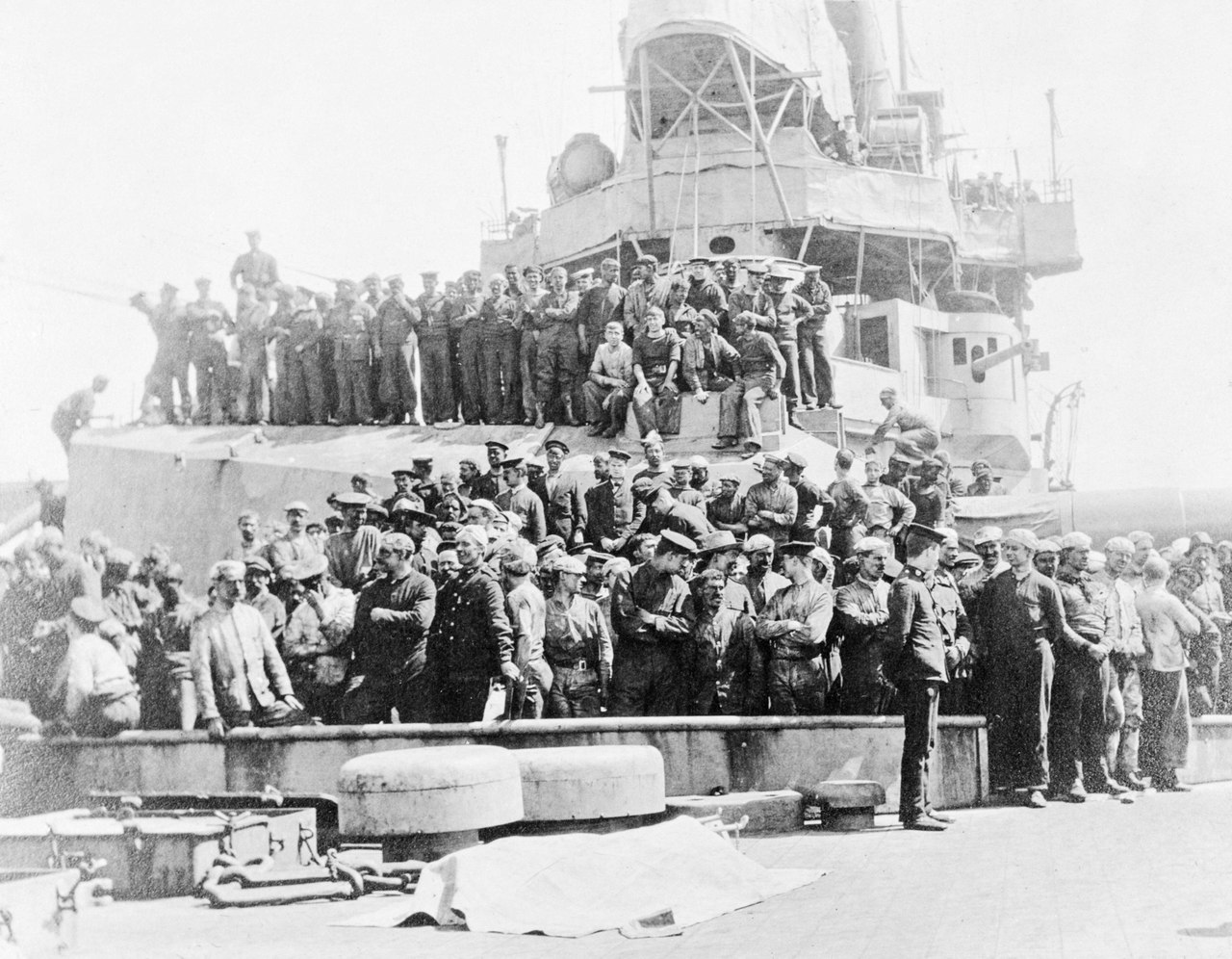
German prisoners aboard Inflexible
The Falklands marked the end of the German raider threat, and the last surface battle of the war fought entirely by gunfire. A few armed merchant ships remained at large, but they could be dealt with relatively easily, releasing ships and men for the vital confrontation in the North Sea. Fisher luxuriated in the praise he received for the only clean victory of the war at sea, correctly viewing the battle as a vindication of the ideas behind the battlecruiser. But his dislike for Sturdee made him ungracious in victory, harping on Dresden's escape and attempting to deny him the honors that traditionally went to the Admiral who won a battle. It would take until after his departure from the Admiralty for Sturdee to receive his baronetcy. But he had wiped out the stain of Coronel from the navy's and the nation's honor, and brought an end to German attempts to strangle British trade with the loss of only about 2% of the tonnage that flew the British flag at the start of the war. The Royal Navy had achieved one of its two goals, safeguarding the merchant ships that kept Britain fed. Now, it would have to focus its attention on keeping the High Seas Fleet bottled up.

Comments
Typo: "free reign"
Despite both being common even in serious writing, "free rein" is in fact the correct version of the idiom.
"but it calm and clear" and "then paused the Beagle Channel" both seem to be missing words.
@hnau
I actually made the change, so he was correcting me correctly.
And will fix.
I do wonder if it was possible for the 8.2 inch shells of the S&G to penetrate the turrets of the British BCs (7 inch face armour) and so set them off as at Jutland. Certainly would have been a shock..
I suspect the range ruled it out.
@Andrew: There doesn't seem to be any published data on armor penetration for the 21cm SK/L40, but running the published ballistic data through Nathan Okun's tool suggests that it could penetrate the 7" turret faces out to 7,600 meters, or the 3" roofs beyond 17,300 meters. Unfortunately for the Germans, the range at maximum elevation was only 16,300 meters. So the question is whether they could have reached 7,600 meters if they had closed aggressively rather than turning to flee.
I don't think so, given that the British had no real interest in fighting at close range. (Less to do with armor than with the German 6" guns, but still.) Also worth noting that the British BCs disabled a lot of their safety precautions after Dogger Bank, which had not yet been fought, so there was a decent chance that a penetrating turret hit wouldn't destroy the ship, although it would probably still get a lot of attention.